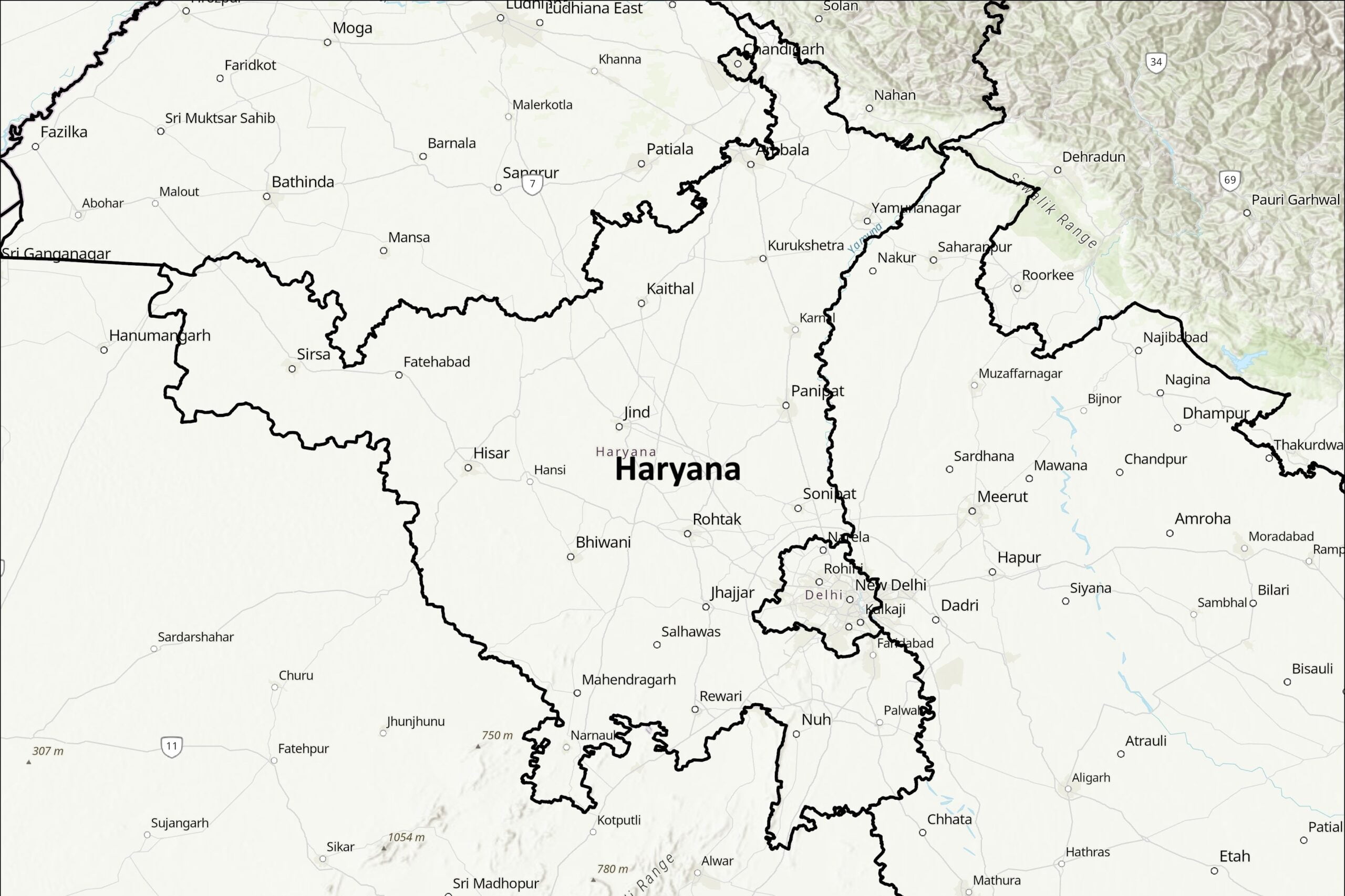There’s no denying the significance geography of Haryana in shaping its identity. Located in Northern India, this state boasts a diverse landscape that ranges from the Aravalli Range in the south to the fertile plains of the Yamuna River in the north. Haryana holds a strategic position as it borders the national capital, New Delhi, and plays a crucial role in India’s agricultural and industrial sectors. With its rich history and vibrant culture, exploring the geography of Haryana offers a unique insight into the heart of India.
Key Takeaways:
- Haryana’s Location: Haryana is a state in northern India, located in the Indo-Gangetic Plains.
- Geographical Features: The geography of Haryana is marked by its fertile plains, the Aravalli mountain range in the southwest, and the Yamuna-Ghaggar plain.
- Climate: Haryana experiences a hot and dry summer, a monsoon season with average rainfall, and a cold winter, typical of a subtropical continental climate.
- Water Bodies: The major rivers flowing through Haryana include the Yamuna, Ghaggar-Hakra, and the Markanda River, providing water for agriculture and other activities.
- Urbanization: With cities like Gurugram and Faridabad experiencing rapid urbanization, Haryana has emerged as one of the fastest-growing states in India.

Physical Geography of Haryana
Topography and Landscape Features
The topography of Haryana is characterized by a diverse landscape that includes the Aravalli Hills in the southwest, fertile plains in the central region, and sandy dunes in the western part. The state is intersected by the Ghaggar-Hakra River and its tributaries, which contribute to the overall geographical diversity of Haryana.
Climate Patterns and Meteorology
The climate of Haryana is classified as semi-arid to sub-humid, with hot summers and cool winters. The region experiences a monsoonal climate, with most of the rainfall occurring during the southwest monsoon season from July to September. The average annual rainfall in Haryana ranges from 350 to 900 millimeters, with the southern parts receiving more rainfall than the northern areas.
Meteorology plays a crucial role in shaping the climate patterns of Haryana. The state experiences extreme weather conditions, with temperatures soaring as high as 45 degrees Celsius in summers and dropping as low as 2 degrees Celsius in winters. These fluctuations in temperature, coupled with erratic rainfall patterns, can have a significant impact on agriculture and water resources in the region.
The semi-arid climate of Haryana poses challenges for agriculture, making irrigation systems vital for crop production. Additionally, the state is prone to frequent dust storms and heatwaves during the summer months, highlighting the importance of preparedness and adaptation to climate change.
Political and Administrative Geography of Haryana
Districts and Administrative Divisions
For Geography of Haryana, the state is divided into 22 districts which are further subdivided into tehsils and blocks for administrative purposes. These districts play a crucial role in the governance and development of the state, each headed by a Deputy Commissioner who oversees the functioning of the district.
Major Cities and Urban Planning
One of the key features of Haryana’s geography is its major cities like Gurugram, Faridabad, and the state capital, Chandigarh. These cities are hubs of economic activity, infrastructure development, and urban planning. Gurugram, known as the “Millennium City,” has rapidly transformed into a leading financial and industrial hub in the region.
Plus, Gurugram and Faridabad are known for their high-rise buildings, corporate offices, and modern infrastructure. However, rapid urbanization has also led to challenges such as traffic congestion, pollution, and strained resources. Efforts towards sustainable urban planning and development are crucial for the future of these cities.
Agricultural and Economic Geography of Haryana
Agricultural Zones and Crop Distribution
To understand the agricultural landscape of Haryana, one must take into account the various agricultural zones present in the state. These zones are critical in delineating the distribution of crops and the overall productivity of the agricultural sector. Haryana can be divided into zones such as the Western Zone, which is known for its cultivation of wheat and mustard, the Central Zone for paddy and wheat, and the Southern Zone for horticultural crops like fruits and vegetables.
Industrial Development and Economic Hubs
Geography plays a crucial role in the industrial development and economic hubs of Haryana. The state is strategically located in the National Capital Region (NCR), which has contributed significantly to its industrial growth. Major industrial hubs such as Gurugram, Faridabad, and Panipat have emerged as key centers for manufacturing, IT services, and textile industries.
Development: Haryana’s proximity to the national capital, New Delhi, has attracted investments and led to the establishment of industrial corridors and special economic zones. The state government has also implemented policies to encourage industrial growth, resulting in the setting up of industrial clusters and promoting sectors like automobile manufacturing, pharmaceuticals, and agro-based industries.
Environmental Concerns and Conservation
Natural Resources and Management
Not only is Haryana one of the most agriculturally productive states in India, but it also boasts mineral-rich lands. However, rapid industrialization and urbanization have put a strain on the state’s natural resources, leading to issues such as groundwater depletion, soil degradation, and air pollution. Proper management strategies are crucial to ensure sustainable utilization of these resources for future generations.
Conservation Efforts and Protected Areas
An integral aspect of environmental protection in Haryana is the establishment of conservation efforts and protected areas. The state is home to various wildlife sanctuaries and conservation reserves, such as the Sultanpur National Park and the Bhindawas Wildlife Sanctuary. These protected areas play a vital role in preserving the rich biodiversity of the region and providing habitats for endangered species.
The government of Haryana, in collaboration with environmental organizations and local communities, has implemented conservation initiatives to safeguard the state’s natural habitats and wildlife. Efforts such as afforestation programs, wildlife conservation projects, and anti-poaching measures have been put in place to combat threats to the environment. Additionally, public awareness campaigns and sustainability programs have been launched to promote environmental conservation among the residents of Haryana.
Cultural and Human Geography of Haryana
Demographics and Population Studies
Many scholars and researchers have explored into the demographics and population studies of Haryana to understand the cultural dynamics of the region. Human settlement patterns, population growth trends, and social composition have been key areas of focus in these studies. Haryana’s population is predominantly rural, with agriculture being the primary occupation for a substantial portion of the population. The state’s demographics show a mix of various communities, including Jats, Punjabis, Brahmins, and Scheduled Castes, each contributing to the cultural richness of the state.
Cultural Landmarks and Heritage Sites
The cultural heritage of Haryana is rich and diverse, with a myriad of landmarks and sites that reflect its historical significance. The state is home to several ancient temples, forts, and monuments that have stood the test of time and bear testament to the region’s glorious past. The Kurukshetra war site, Pinjore Gardens, and the Sheikh Chehli ka Makbara are just a few among the many cultural landmarks that attract tourists and history enthusiasts alike.
Cultural preservation efforts have been made to safeguard these sites and promote tourism, thereby creating awareness about the state’s rich cultural heritage. The intricate architecture, religious significance, and historical importance of these landmarks make them invaluable assets not just for Haryana but for the entire nation.
Summing up
Therefore, the geography of Haryana plays a crucial role in shaping the state’s culture, economy, and environment. With its diverse landscapes ranging from fertile plains to the Aravalli hills, Haryana boasts a rich agricultural sector and a growing industrial presence. The state’s strategic location as a gateway to northern India further enhances its importance in the country. Understanding the geographical features and facts about Haryana provides valuable insights into the region’s past, present, and future development. Overall, the geography of Haryana reflects a balance between tradition and modernization, making it a significant contributor to India’s diverse tapestry.
Visit Haryana Official Website: click here







